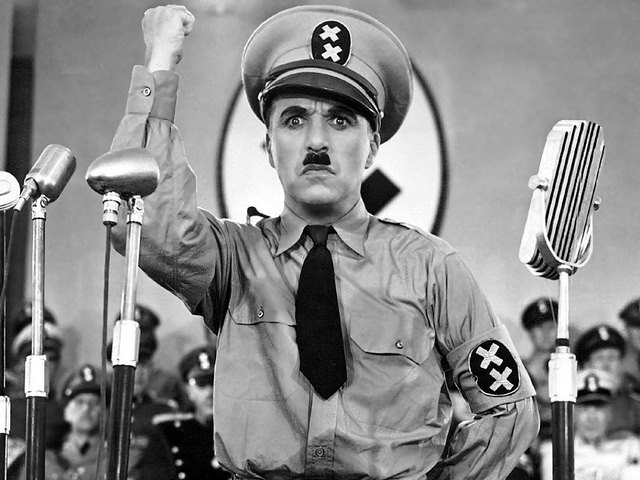Chrissy Goodall – History
I became interested in film history, and particularly Hollywood during the interwar years, after stumbling upon Charlie Chaplin’s iconic film, The Great Dictator. The picture, which was released in America in October 1940, is an unapologetic political satire of the European dictators of the period. The production of this aggressive anti-isolationist film surprised me, as at the time of its release, America refused to be involved in the war in Europe. The picture violated the country’s claim to neutrality and thus, I wanted to explore the contemporary reaction to the film, both in America and across the World. Moreover, I sought to investigate if the production of The Great Dictator was an exception or the norm – was Hollywood regularly producing blatant anti-Nazi pictures in a period of supposed American neutrality? I wanted to explore if the film studios were united in their response to fascist threats in Europe or if the politically charged pictures, that were later termed ‘propaganda’ in the 1941 Senate Hearings, were the product of a few ambitious and empathetic individuals and studios.
My thesis primarily used sources held in the in the Academy of Motion Picture Arts and Sciences in Los Angeles. I was able to conduct this research due to the generous funding I received from College. The sources include correspondence between the studios and the Production Code Administration, which censored Hollywood’s output after 1934; and the personal papers of actors, screenwriters and producers. In addition, I used contemporary newspaper reviews of the films and Box Office rental figures, which allowed me to compare critical response with audience uptake. These documents allowed me to investigate the reactions of the eight major film studios to America’s involvement in the war in Europe.
Following this research, I found that The Great Dictator was not alone in its fierce condemnation of the fascist regimes in Europe. Yet the prominence of several anti-fascist pictures produced in this period has constructed an overly optimistic image of Hollywood as a bastion of liberty and democracy against European fascism. This misconception encourages one to forget that the motion picture industry was, first and foremost, an industry. The studios made films, however politically charged, to make money. The majority of Hollywood studios did not attempt to dramatise the Spanish Civil War (1936-9), for instance, because they recognised that American audiences visited the cinema for entertainment, not to be troubled by serious moralising pleas. Thus, the few pictures that portrayed the suffering inflicted by General Franco’s fascism regime were unsurprisingly unprofitable.
This was also true of the early anti-Nazi pictures, such as Confessions of a Nazi Spy and Hitler-Beast of Berlin. These fierce cinematic condemnations were the reaction of a few bold, and predominantly independent, producers to the anti-Jewish attacks of Kristallnacht in Germany in 1938. Their disregard of the revenue produced by the European market allowed these producers, to an extent, to prioritise their politics ahead of their purses. In this period, the revenue produced by this market was crucial, as domestic rental money was commonly used to cover production costs. However, as the European dictators expanded their territories later in the decade, this essential source of income was threatened. In 1936, only twenty ‘ideologically approved’ Hollywood films were allowed into Germany and by 1940, Adolf Hitler had banned the importation and distribution of all American films in Nazi-controlled territories. Despite the Italians’ large appetite for Hollywood films in the previous decade, Benito Mussolini imposed a similar ban in 1941. Thus, it is more telling that the major studios, with the exception of Warner Brothers, did not dare to condemn Hitler’s barbaric racial programme, in fear that they would lose the lucrative German market.
With Hitler’s total ban on Hollywood imports in Nazi-controlled territories on 17 August 1940, the studios were forced to rely on the British Commonwealth market for their profits. Thus, it is no coincidence that a flurry of pro-British pictures, including The Sea Hawk and A Yank in the R.A.F., appeared in theatres in the latter half of 1940 and throughout 1941. However, access to these profits proved difficult without the assistance of the White House. This provided Hollywood with a strong financial incentive to produce pictures that demonstrated their support of President Roosevelt’s foreign policy.
Following the Fall of France in June 1940, Roosevelt recognised the need for American intervention in the war in Europe and from September 1940, the President committed his country to war, albeit in secret. This long-term interventionist agenda was drip-fed to the nation through the President’s Fireside Chats. Roosevelt’s emphasis on military preparedness, coupled with the need to protect American ideals, was popularised by film productions, such as Buck Privates and Sergeant York. By providing a solution to Hollywood’s financial situation, Roosevelt attempted to harness mass culture to build widespread support for his interventionist foreign policy. From this point, the studios were united in their reaction to the war in Europe - not only with one another but also with President Roosevelt. Yet despite their best efforts, the President and Hollywood failed to achieve a consensus in support of American military intervention.
The Japanese attack on Pearl Harbor on 7 December 1941 unified the nation in a way that had been previously impossible. Less than twenty-four hours after the attack, a joint session of Senators and Representatives overwhelming voted in favour of war with Japan. Three days later, America was also at war with Nazi Germany and Fascist Italy. After two years of nervous diplomacy and indecision, Hollywood could finally concentrate on producing the enthusiastically patriotic and morale-boosting pictures that were certain Box Office smash hits.
Further Exploration
Academy of Motion Picture Arts and Sciences
Confessions of a Nazi Spy (1939)

